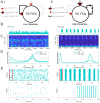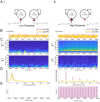A biophysical model of striatal microcircuits suggests gamma and beta oscillations interleaved at delta/theta frequencies mediate periodicity in motor control
- PMID: 32097404
- PMCID: PMC7059970
- DOI: 10.1371/journal.pcbi.1007300
A biophysical model of striatal microcircuits suggests gamma and beta oscillations interleaved at delta/theta frequencies mediate periodicity in motor control
Abstract
Striatal oscillatory activity is associated with movement, reward, and decision-making, and observed in several interacting frequency bands. Local field potential recordings in rodent striatum show dopamine- and reward-dependent transitions between two states: a "spontaneous" state involving β (∼15-30 Hz) and low γ (∼40-60 Hz), and a state involving θ (∼4-8 Hz) and high γ (∼60-100 Hz) in response to dopaminergic agonism and reward. The mechanisms underlying these rhythmic dynamics, their interactions, and their functional consequences are not well understood. In this paper, we propose a biophysical model of striatal microcircuits that comprehensively describes the generation and interaction of these rhythms, as well as their modulation by dopamine. Building on previous modeling and experimental work suggesting that striatal projection neurons (SPNs) are capable of generating β oscillations, we show that networks of striatal fast-spiking interneurons (FSIs) are capable of generating δ/θ (ie, 2 to 6 Hz) and γ rhythms. Under simulated low dopaminergic tone our model FSI network produces low γ band oscillations, while under high dopaminergic tone the FSI network produces high γ band activity nested within a δ/θ oscillation. SPN networks produce β rhythms in both conditions, but under high dopaminergic tone, this β oscillation is interrupted by δ/θ-periodic bursts of γ-frequency FSI inhibition. Thus, in the high dopamine state, packets of FSI γ and SPN β alternate at a δ/θ timescale. In addition to a mechanistic explanation for previously observed rhythmic interactions and transitions, our model suggests a hypothesis as to how the relationship between dopamine and rhythmicity impacts motor function. We hypothesize that high dopamine-induced periodic FSI γ-rhythmic inhibition enables switching between β-rhythmic SPN cell assemblies representing the currently active motor program, and thus that dopamine facilitates movement in part by allowing for rapid, periodic shifts in motor program execution.
Conflict of interest statement
The authors have declared that no competing interests exist.
Figures







Similar articles
-
Desynchronization of fast-spiking interneurons reduces β-band oscillations and imbalance in firing in the dopamine-depleted striatum.J Neurosci. 2015 Jan 21;35(3):1149-59. doi: 10.1523/JNEUROSCI.3490-14.2015. J Neurosci. 2015. PMID: 25609629 Free PMC article.
-
Fast oscillations in cortical-striatal networks switch frequency following rewarding events and stimulant drugs.Eur J Neurosci. 2009 Sep;30(5):848-59. doi: 10.1111/j.1460-9568.2009.06843.x. Epub 2009 Jul 31. Eur J Neurosci. 2009. PMID: 19659455 Free PMC article.
-
Enhanced high-frequency membrane potential fluctuations control spike output in striatal fast-spiking interneurones in vivo.J Physiol. 2011 Sep 1;589(17):4365-81. doi: 10.1113/jphysiol.2011.212944. Epub 2011 Jul 11. J Physiol. 2011. PMID: 21746788 Free PMC article.
-
Dopamine-modulated dynamic cell assemblies generated by the GABAergic striatal microcircuit.Neural Netw. 2009 Oct;22(8):1174-88. doi: 10.1016/j.neunet.2009.07.018. Epub 2009 Jul 19. Neural Netw. 2009. PMID: 19646846 Review.
-
Modeling the Generation of Phase-Amplitude Coupling in Cortical Circuits: From Detailed Networks to Neural Mass Models.Biomed Res Int. 2015;2015:915606. doi: 10.1155/2015/915606. Epub 2015 Oct 11. Biomed Res Int. 2015. PMID: 26539537 Free PMC article. Review.
Cited by
-
Translating Pathological Brain Activity Primers in Parkinson's Disease Research.Research (Wash D C). 2023 Jun 27;6:0183. doi: 10.34133/research.0183. eCollection 2023. Research (Wash D C). 2023. PMID: 37383218 Free PMC article. Review.
-
M-current induced Bogdanov-Takens bifurcation and switching of neuron excitability class.J Math Neurosci. 2021 Feb 15;11(1):5. doi: 10.1186/s13408-021-00103-5. J Math Neurosci. 2021. PMID: 33587210 Free PMC article.
-
Early synaptic dysfunction of striatal parvalbumin interneurons in a mouse model of Parkinson's disease.iScience. 2024 Oct 24;27(11):111253. doi: 10.1016/j.isci.2024.111253. eCollection 2024 Nov 15. iScience. 2024. PMID: 39563890 Free PMC article.
-
Functional Autapses Form in Striatal Parvalbumin Interneurons but not Medium Spiny Projection Neurons.Neurosci Bull. 2023 Apr;39(4):576-588. doi: 10.1007/s12264-022-00991-x. Epub 2022 Dec 11. Neurosci Bull. 2023. PMID: 36502511 Free PMC article.
-
Altered oscillatory coupling reflects possible inhibitory interneuron dysfunction in Rett syndrome.medRxiv [Preprint]. 2025 Jul 22:2025.07.21.25331927. doi: 10.1101/2025.07.21.25331927. medRxiv. 2025. PMID: 40778166 Free PMC article. Preprint.
References
-
- Rothe T, Deliano M, Wójtowicz AM, Dvorzhak A, Harnack D, Paul S, et al. Pathological gamma oscillations, impaired dopamine release, synapse loss and reduced dynamic range of unitary glutamatergic synaptic transmission in the striatum of hypokinetic Q175 Huntington mice. Neuroscience. 2015;311:519–538. 10.1016/j.neuroscience.2015.10.039 - DOI - PubMed
Publication types
MeSH terms
Substances
Grants and funding
LinkOut - more resources
Full Text Sources

